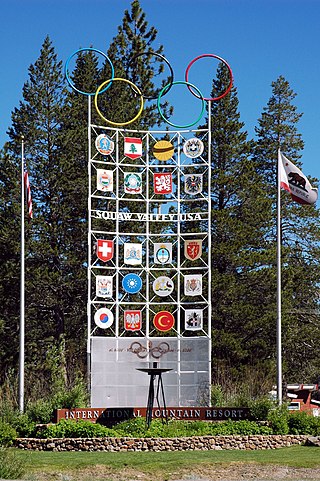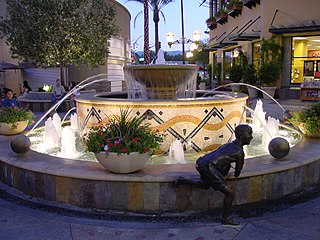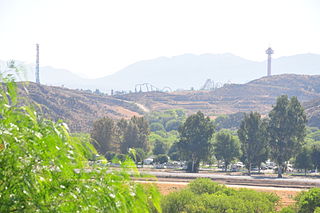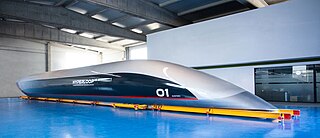Related Research Articles

The East Bay Regional Park District (EBRPD) is a special district operating in Alameda County and Contra Costa County, California, within the East Bay area of the San Francisco Bay Area. It maintains and operates a system of regional parks which is the largest urban regional park district in the United States. The administrative office is located in Oakland.

California High-Speed Rail (CAHSR) is a publicly funded high-speed rail system being developed in California by the California High-Speed Rail Authority. Phase 1, about 494 miles (795 km) long, is planned to run from San Francisco to Los Angeles and Anaheim via the Central Valley, and is partially funded and under construction. A proposed Phase 2 would extend the system north to Sacramento and south to San Diego, for a total of 776 miles (1,249 km). The project was authorized by a 2008 statewide ballot to connect the state's major urban areas and reduce intercity travel times. Phase 1 targets a nonstop travel time of 2 hours and 40 minutes from San Francisco to Los Angeles, compared to about nine hours on the existing Amtrak San Joaquins.

Olympic Valley is an unincorporated community located in Placer County, California northwest of Tahoe City along California State Highway 89 on the banks of the Truckee River near Lake Tahoe. It is home to Palisades Tahoe, the site of the 1960 Winter Olympics. Olympic Valley is the smallest resort area to host the Olympic Winter Games.

Paradise Valley is a census-designated place (CDP) in Humboldt County, Nevada, United States, near the Santa Rosa Ranger District of Humboldt National Forest. It is located at the northern terminus of Nevada State Route 290, about 19 miles (31 km) northeast of U.S. Highway 95 and a total of 40 miles (64 km) north of Winnemucca. The town is located in a broad valley, with the Santa Rosa Range of mountains just to the northwest. At the 2010 census, the population of the CDP was 109.

Palisades Tahoe is a ski resort in the western United States, located in Olympic Valley, California, northwest of Tahoe City in the Sierra Nevada range. From its founding in 1949, the resort was known as Squaw Valley, but it changed its name in 2021 due to the derogatory connotations of the word "squaw". It was the host site for the 1960 Winter Olympics.

The California Department of Water Resources (DWR) is part of the California Natural Resources Agency and is responsible for the management and regulation of the State of California's water usage. The department was created in 1956 by Governor Goodwin Knight following severe flooding across Northern California in 1955, where they combined the Division of Water Resources of the Department of Public Works with the State Engineer's Office, the Water Project Authority, and the State Water Resources Board. It is headquartered in Sacramento.

Santa Clarita is a city in northwestern Los Angeles County in the U.S. state of California. With a 2020 census population of 228,673, it is the third-most populous city in Los Angeles County, the 17th-most populous in California, and the 103rd-most populous city in the United States. It is located about 30 miles (48 km) northwest of downtown Los Angeles, and occupies 70.75 square miles (183.2 km2) of land in the Santa Clarita Valley, along the Santa Clara River. It is a classic example of a U.S. edge city, satellite city, or boomburb.

Arroyo Burro Beach, also known as Hendry's Beach by local residents, is a public beach in Santa Barbara County, California. Located off of Cliff Drive, it is the terminus of Arroyo Burro Creek, and stands at the foot of the Santa Barbara coastal bluffs of the Wilcox Property, which is adjacent to the east. The community of Hope Ranch is about 1 mi (1.6 km) to the west.
Aera Energy LLC is a natural gas, oil exploration and production company started as a joint venture between Shell plc and Mobil. Headquartered in Bakersfield, California, Aera Energy LLC is a California limited liability company, and one of California's largest oil and natural gas producers, with an approximate 2015 revenues of over $2 billion. Aera is operated as a stand-alone company through its board of managers.
Tejon Mountain Village is a proposed residential, commercial, and recreational development of pristine, rugged property in the Tehachapi Mountains owned by the Tejon Ranch Company in Lebec, southern Kern County, California. The development includes the largest conservation and land-use agreement in California history. It was approved by the county's Board of Supervisors in October 2009. Opponents launched a legal challenge that was denied in state district court in April 2012.

Valencia is an unincorporated community in northwestern Los Angeles County, California, United States. The area, west of Interstate 5, is expanding with residential development and already includes major commercial and industrial parks. It straddles State Route 126 and the Santa Clara River.

Hyperloop is a proposed high-speed transportation system for both passengers and freight. The concept was documented by Elon Musk in a 2013 white paper, where the hyperloop was described as a transportation system using capsules supported by an air-bearing surface within a low-pressure tube. Hyperloop systems have three essential elements: tubes, pods, and terminals. The tube is a large, sealed low-pressure system. The pod is a coach at atmospheric pressure that experiences low air resistance or friction inside the tube using magnetic propulsion. The terminal handles pod arrivals and departures. The hyperloop, in the form proposed by Musk, differs from traditional vactrains by relying on residual air pressure inside the tube to provide lift from aerofoils and propulsion by fans; however, many subsequent variants using the name "hyperloop" have remained relatively close to the core principles of vactrains.

Hyperloop Transportation Technologies, also known as HyperloopTT, is an American research company formed using a crowd collaboration approach to develop around the world commercial transportation systems based on the Hyperloop concept.
Jumpstarter, Inc is a California-based company. The company builds technology solutions to allow crowd collaboration. The technology allows for a combination of crowdsourcing and crowdfunding. The company has its own web portal, jumpstartfund, through which it explores the concept of a crowd-powered incubator. The company is known for picking Elon Musk's idea of Hyperloop and incorporating it as founding party under Hyperloop Transportation Technologies Inc.

Shervin Kordary Pishevar is an Iranian-American entrepreneur, venture capitalist, super angel investor, and philanthropist. He is the co-founder and former executive chairman of Hyperloop One and a co-founder and managing director of Sherpa Capital, a venture capital fund which has invested in companies including Airbnb, Uber, GoPuff, Cue Health, Slack, Robinhood, Munchery and Postmates.

The California High-Speed Rail Authority was established in 1996 after decades of advocacy for building a high speed rail system in California. The passage of Proposition 1A in 2008, followed by the awarding of federal stimulus funds in 2010, established the initial funding for the California High-Speed Rail system. Construction contracts began to be awarded in 2013, and the groundbreaking ceremony for initial construction was held on January 6, 2015.
Centennial, California is a proposed 12,323-acre (49.87 km2) master-planned community on Tejon Ranch in northwestern Los Angeles County between Bakersfield and Los Angeles. It is situated in the far western Antelope Valley at the foothills of the Sierra Pelona and Tehachapi Mountains. It would be built along California State Route 138 east of Interstate 5 and northeast of Quail Lake.

Dirk Ahlborn is an entrepreneur, investor, and an American businessman. He is from Berlin and currently works in California; he holds a U.S. citizenship and is the founder and Chairman of Hyperloop Transportation Technologies and CEO of Jumpstarter, Inc.

Brewer Island is an island in the San Francisco Bay, in San Mateo County, California. Originally owned by W. P. A. Brewer, for over one hundred years it was used for hay farming. Several attempts to develop the island failed between 1912 and 1959. Ultimately, a venture by Richard Grant and T. Jack Foster succeeded in 1960; Brewer Island's surface was raised by 6 ft (1.8 m), an artificial lake was dug in its center, and it became the location of what is now known as Foster City.
Storyliving by Disney is a business venture and brand of The Walt Disney Company announced on February 16, 2022, to collaboratively develop master-planned communities that utilize Disney Imagineering and are staffed by Disney cast members. It operates under the company's Disney Living Development, Inc. subsidiary. Cotino, in Rancho Mirage, California, was the first Storyliving by Disney community chosen for development, where ground breaking took place in April 2022. In December 2023, plans were announced for a second such community, named Asteria, in Pittsboro, North Carolina.
References
- ↑ "Quay Valley website - Facts". Archived from the original on September 1, 2007. Retrieved August 13, 2007.
- ↑ "Quay Valley Fact Sheet" . Retrieved January 23, 2016.
- 1 2 Nidever, Seth (April 12, 2010). "Proposed city still a paper dream". The Sentinel. Hanford, California. Retrieved April 12, 2010.
- 1 2 3 Kings County Board of Supervisors Action Summary of the December 12, 2017 meeting
- 1 2 3 "Fresno Bee", December 23, 2017
- ↑ Karlin, Beth (Mar 1, 2007). "Green Growth". National Real Estate Investor. Retrieved Mar 1, 2007.
- 1 2 Chee, Alexander (December 4, 2015). "The Race to Create Elon Musk's Hyperloop Heats Up". The Wall Street Journal. Retrieved January 23, 2015.
His first attempt to launch Quay Valley was thwarted by litigation over water rights and the financial crisis of 2008; the new plan is to break ground on the site, a 7,200-acre expanse halfway between Los Angeles and San Francisco, sometime in 2016.
- 1 2 "Kings County Ventures, LLC". Business Entity Detail. Archived from the original on April 1, 2001. Retrieved January 23, 2016.
Enter Kings County Ventures in LLC category to see results
- ↑ Quay Valley (July 31, 2008). "Quay Valley on Track to Become First Green City in United States". Express Press Release Illinois. Retrieved July 31, 2008.
- ↑ "Jury awards $128.6M to failed solar town developer". TBJ Now. Associated Press. April 1, 2014. Retrieved January 23, 2016.
- 1 2 Upbin, Bruce (26 February 2015). "Hyperloop Gets Its First Commercial Contract For Short Track In California". Forbes. Retrieved March 5, 2015.
- ↑ Griswold, Lewis (February 24, 2015). "Quay Valley new town project re-emerges in Kings County". The Fresno Bee. Retrieved March 5, 2015.
- ↑ "New city proposed for Central Valley". Central Valley Business Times. February 24, 2015. Retrieved 3 March 2015.
- ↑ Nidever, Seth (February 27, 2015). "Plan resurrected for new Kings County city". The Sentinel. Hanford, California. Retrieved January 23, 2016.
- 1 2 Sheehan, Tim (March 7, 2015). "Futuristic city planned for Kings County gets people-mover to match". The Fresno Bee. Retrieved January 23, 2016.
- ↑ Owano, Nancy (March 1, 2015). "Construction begins 2016 for Hyperloop on five-mile stretch". Tech Xplore. Retrieved 5 March 2015.
- ↑ "Archived copy". countyofkings.com. Archived from the original on 12 May 2016. Retrieved 25 January 2022.
{{cite web}}: CS1 maint: archived copy as title (link)